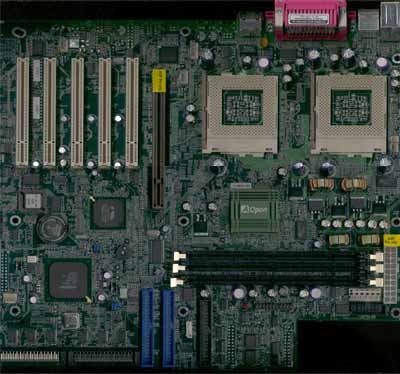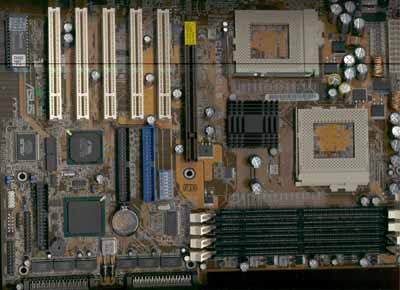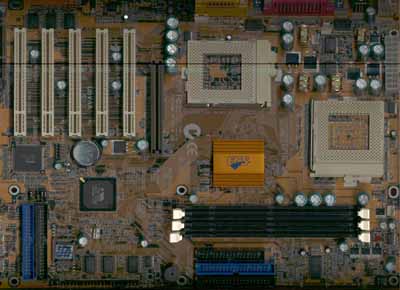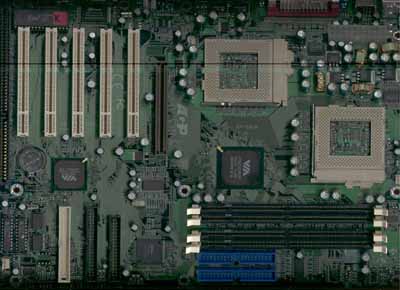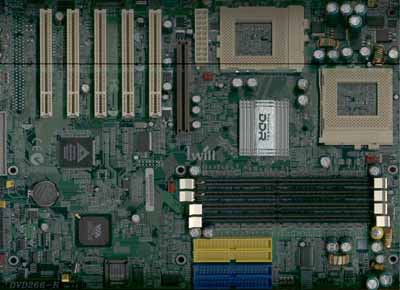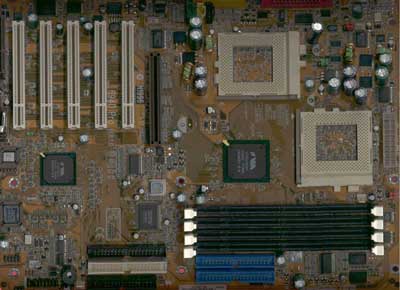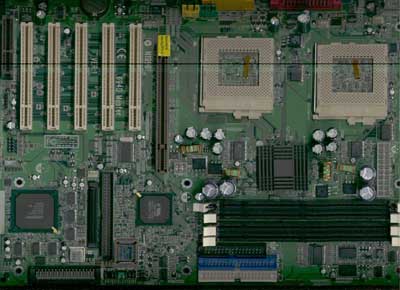
Original Link: https://www.anandtech.com/show/816
Value Dual Socket-370 Motherboard Roundup - August 2001
by Mike Andrawes on August 24, 2001 12:00 PM EST- Posted in
- Motherboards
Introduction
Just a few years ago, the phrase "dual processor system" was nothing more than a dream for most of us in the hardware community as it was mostly reserved for high-end servers or workstations. The simple reason, of course, was the prohibitively high price of such a system, which was the result of a few different factors. For starters, the processors prices were still relatively high, which made buying a second processor that much more expensive. Moreover, not all CPUs supported SMP back in the day. Similarly, only a handful of chipsets were available to support SMP, with a similarly high price tag, of course, that in turn raised the cost of such motherboards.
But quite possibly the biggest hindrance to the proliferation of SMP was the lack of mainstream OS support. Windows NT was the closest thing we had to a "mainstream" OS that supported SMP, but it's big problem was the lack of support for devices like USB and certain API's, such as Direct3D.
A lot of credit for this change can be given to the ABIT BP6, which took the relatively inexpensive i440BX chipset and teamed it up with two Socket-370 interfaces. At the time, the only Socket-370 CPU available was Intel's value oriented Celeron. Intel never officially supported SMP operation on Celeron's, which made ABIT's accomplishment that much more impressive. Unfortunately, the i440BX was already beginning to age and lacked quite a few features that newer chipsets supported, including AGP 4X, Ultra ATA 66/100, and official 133MHz FSB support.
More recently, VIA's announcement that their Apollo Pro 133A chipset was capable of supporting SMP was a big step in pushing SMP into the home user market. Besides the price, at that time the VIA Apollo Pro133A chipset was a pretty mature chipset, being in the market for quite some time already as a single processor solution. A lot of manufacturers were quite familiar and confident with their Apollo Pro133A designs, so taking the next step to enable SMP wasn't as difficult as it might otherwise be.
Further, the competition from AMD's Athlon/Duron processor have forced Intel to cut prices drastically as well. Even if you only consider top of the line processors, they are sold at much cheaper prices compared to high-end models of even one year ago.
The last key to the increased interest in SMP is the availability of Windows 2000, Microsoft's first NT based OS that offered hardware and API support comparable to the Windows 9X counterparts. At the same time, Linux continues to get more and more attention these days, which also flourishes with multiple processors.
It's been over a year since we first VIA Apollo Pro133A based dual Socket-370 motherboard, namely the MSI 694D Pro. Since then, almost everyone has released a competing solution and we've taken a look at some of the more popular ones with this roundup.
It turns out this roundup is quite different from those we have done in the
past. In most of our past roundups, all the boards are more or less the same,
using the same chipset with the same basic features forcing us to differentiate
them primarily by performance and stability. As you will see, we found quite
a few differences among the dual Socket-370 motherboards.
For the roundup, we are able to gather quite a few contenders, including the
ABIT VP6, Acorp 6A815EPD, AOpen DX34 Plus, ASUS CUV4X-DLS, ECS D6VAA, EPoX D3VA,
Gigabyte 6VXD7, Iwill DVD266-R, MSI 694D Pro, and MSI 694D Master-S.
Competition among chipsets
In this roundup, the competition is not just between motherboards, but also a competition among chipsets as well. While there are quite a few chipsets in the market supporting SMP with the Pentium III, many of them are simply too expensive to be used in a value SMP system. Nevertheless, among the ten contestants here, there are a total of three chipsets used, showing that there is quite a bit of support for value market SMP systems.
The first, and also the most commonly used, is the VIA Apollo Pro133A. It was indeed one of the first chipset officially supporting SMP and the 133MHz front side bus. Thanks to the high cost of RDRAM with little to no performance advantage (in fact a disadvantage in many cases), Intel's i820 essentially flopped, making the Apollo Pro133A effectively the only official 133MHz FSB chipset on the market for quite some time.
The VIA Apollo Pro266 is the second chipset we found used on many of these motherboards. As the name implies, it is the successor to the Apollo Pro133A, although quite a bit has changed. The most obvious change is that the Apollo Pro266 supports DDR SDRAM instead of the traditional SDR SDRAM. While the Apollo Pro266 has not been able to boost the performance of single processor system too much, mainly because the Pentium III is not particularly memory hungry, it's potential with multiple processors was certainly promising. Another major design change is the use of the V-link architecture between the north and south bridges for more bandwidth and lower pincount. This is very similar to Intel's Hub Architecture.
Interestingly enough, we saw a very unlikely chipset used for SMP in this roundup, the Intel i815EP chipset. Officially the Intel i815EP chipset does not support any SMP system at all, and only a single motherboard manufacturer had mentioned an SMP motherboard using the chipset. Just days before this roundup was completed, we received a board from Acorp International, a motherboard manufacturer in Taiwan. They are, of course, that one brave manufacturer to announce an SMP i815EP board.
This is quite an engineering feet by Acorp since they obviously got no help from Intel in designing it since they do not support SMP on the i815EP. Kudos to Acorp for going out on a limb, and possibly raising some eyebrows over at Intel, for producing such a board. The i815EP of course is very promising as an SMP chipset because it performed so well as a uniprocessor chipset. Even with DDR SDRAM, the Apollo Pro 266 can barely keep up with the i815EP with a single processor.
In terms of features, all three chipsets supports AGP 1X, 2X, and 4X, official 133MHz FSB, and Ultra ATA 100. Both the Apollo Pro133A and the Apollo Pro266 support up to 4GB of memory, while the i815EP is limited to a mere 512MB, which is not nearly enough for most modern servers. Nevertheless, it could be a very affordable SMP chipset for a home system.
The Apollo Pro133A and the i815EP chipsets support a total of four USB ports. Generally, two traditional ports are installed at the back of the board within the ATX I/O panel, while the second set of connectors for the third and forth ports requires the use of a bracket, which is provided by most manufacturers. The Apollo Pro266 takes things one step further and supports a total of six USB ports.
ABIT VP6
|
ABIT VP6 |
|
|
CPU
Interface
|
Socket-370
|
|
Chipset
|
VIA
Apollo Pro133A
VT 694X North Bridge VT 686B South Bridge |
|
Form
Factor
|
ATX
|
|
Bus
Speeds
|
66 - 178MHz (in 1MHz increments) |
|
Voltages
Supported
|
Auto
Detect |
|
Memory
Slots
|
4
168-pin DIMM Slots
|
|
Expansion
Slots
|
1
AGP Slot |
|
On-board
Audio
|
N/A
|
|
BIOS
|
Award Modular BIOS 6.00PG |
Overclocking has been the key to ABIT's success, going back to the introduction of SoftMenu seemingly eons ago. That trend continues today with all their products, including the VP6. Accordingly, within the BIOS you can find a wide variety of memory and voltage tweaking options.

Memory tweaking options.
The big overclocking feature, however, is availability of 1MHz increments for the FSB, something we hardly saw in any other dual Socket-370 motherboard. This setting allows you to fine-tune your FSB to maximize the overclocking potential of your CPU. Thanks to the clean design of the board, we were able to hit a FSB speed of 155MHz without compromising the stability of the system.
In classic ABIT fashion, you should have no problem fitting large HSF units on the motherboard since ABIT has made sure that there is plenty of space around both CPU sockets. Further, four memory slots are available, giving you added flexibility when it comes to memory configuration.
Like most other recent ABIT products, the VP6 is outfitted with the Highpoint IDE RAID controller as well. The controller allows RAID 0, RAID 1, and RAID 0+1 setups. Of course, you can disable the RAID functionality and just use the controller as another IDE controller.


The Highpoint IDE RAID controller and connectors.
The only problem we encountered during testing was in the stability department, where the VP6 wasn't exactly the most stable board in the lab.
Overall, the VP6 is a board with a clear target market - the overclockers looking to dabble with SMP.. The only downside is stability, but otherwise the VP6 contains pretty much everything that a hardware enthusiasts could ask for.
Acorp 6A815EPD
|
Acorp 6A815EPD |
|
|
CPU
Interface
|
Socket-370
|
|
Chipset
|
Intel
815EP
Intel 82815 MCH Intel 82801BA ICH2 |
|
Form
Factor
|
ATX
|
|
Bus
Speeds
|
100 / 102 / 105 / 133 / 134 / 137 / 140 / 145 / 150 / 160 MHz |
|
Voltages
Supported
|
Auto Detect |
|
Memory
Slots
|
3
168-pin SDR DIMM Slots
|
|
Expansion
Slots
|
1
AGP Slot |
|
On-board
Audio
|
N/A
|
|
BIOS
|
Award Modular BIOS 6.00PG |
The Acorp 6A815EPD is the only SMP we've seen using the Intel i815EP chipset. There is one reason for the lack of such boards - Intel does not officially support SMP operation with the i815EP, although Acorp has obviously shown us that it is possible. Of course, the i815EP has a few inherent disadvantages in the SMP market, most notably the 512MB memory limit, which may be enough for the vast majority of individual users, but simply won't cut it for any powerful server.

The Intel i815 MCH supporting SMP.

The Intel 82801BA ICH2.
The performance of the board is pretty good, showing that SMP runs smoothly on the 6A815EPD. There is quite a bit of space around both CPU sockets, so you should have no problem installing largeer HSF units. On the other hand, the board has only three DIMM slots, which is inline with the chipset spec. Remember that those chipset specs require the dropping back to PC100 memory speeds when using more than 4 banks of memory.
The 6A815EPD was quite stable in our testing under non-overclocked circumstances, but didn't fare too well when it comes time to overclock.. In fact we weren't able to perform any overclocking test on the board, since setting the FSB to 134MHz would cause the system to crash immediately upon boot up. It's a bit odd that a 1MHz FSB overclock would take a board from rock solid to completely unstable, but that's what happened on our evaluation sample.
The board also features a RAID setup, using the same Promise PDC20265R controller we've seen elsewhere to provide RAID 0 and RAID 1 functionality. Like most other boards that use the Promise controller, RAID 0+1 is not available despite the fact that the controller supports it. This is most likely a licensing issue with Promise that is designed to lower the cost of the controller chips.

The Promise IDE RAID controller.
Overall, the 6A815EPD has a lot of promise, but comes out as an average dual Socket-370 motherboard, mainly due to its inability to overclock. The chipset's memory limitations don't help the situation any, although there is no doubt that the 815EP chipset is faster than the other options in this roundup. If you don't plan to overclock and don't need more than 512MB of memory, then the Acorp 6A815EPD is an excellent choice.
AOpen DX34 Plus
|
AOpen DX34 Plus |
|
|
CPU
Interface
|
Socket-370
|
|
Chipset
|
VIA
Apollo Pro133A
VT 694X North Bridge VT 686A South Bridge |
|
Form
Factor
|
ATX
|
|
Bus
Speeds
|
Auto Detect |
|
Voltages
Supported
|
Auto Detect |
|
Memory
Slots
|
3
168-pin DIMM Slots
|
|
Expansion
Slots
|
1
AGP Slot |
|
On-board
Audio
|
Analog
Device AD1885 AC’97 CODEC
|
|
BIOS
|
AOpen
self-design System BIOS v4.0 |
The DX34 Plus we received from AOpen was only an engineering sample, but its performance and stability were quite good already. The stability of the board was up to par with other contenders in this roundup, although we believe that the performance of the board could further be improved.
The board features an AGP Pro slot, so users with professional graphics cards
should pay attention to this board. Unfortunately, the DX34Plus only has three
DIMM slots, where most other boards with VIA Apollo Pro133A chipset have four,
so you lose some flexibility in memory configuration.

The AGP Pro slot.
The DX34Plus definitely targets the high-end market as evidenced by its integrated SCSI controller. AOpen uses the Adaptec AIC-7899G SCSI controller and provide a total of two 68-pin Ultra 160 SCSI channels. Moreover, the board also has an integrated Intel 82559 Ethernet controller, with the Ethernet port located within the I/O panel.

The Adaptec Ultra-160 SCSI controller.

The two 68-pin SCSI connectors.


The Intel Ethernet controller and the connector.
Unfortunately, this board offers no overclocking features at all. The BIOS for the board is designed by AOpen, and there are no overclocking options at all for the FSB. There are only a few memory-tweaking options in the BIOS, so you can't really boost any performance in that way either. Ultimately AOpen was trying to make a rock solid board for server applications, and overclocking was definitely not a priority in their mind.



AOpen's self designed BIOS for server boards.
You also have to be careful with larger HSF units since a lot of the capacitors are located very close to the CPU sockets. Even the Taisol HSF units we used during the testing hardly fit on the board.
In short, the DX34 Plus is a rock solid board in terms of stability and comes with onboard SCSI and ethernet, making it perfect for a server environment. On the other hand, without overclocking options, it's hard to recommend the DX34 Plus to the hardware enthusiast.
ASUS CUV4X-DLS
|
ASUS CUV4X-DLS |
|
|
CPU
Interface
|
Socket-370
|
|
Chipset
|
VIA
Apollo Pro133A
VT 694X North Bridge VT 686B South Bridge |
|
Form
Factor
|
ATX
|
|
Bus
Speeds
|
66 / 68 / 75 / 80 / 83 / 85 / 90 / 95 / 100 / 102 / 105 / 110 / 112 / 115 / 116 / 118 / 120 / 124 / 126 / 130 / 133 / 135 / 138 / 140 / 142 / 144 / 146 / 148 / 150 / 155 / 160 / 166 MHz |
|
Voltages
Supported
|
Auto Detect |
|
Memory
Slots
|
4
168-pin DIMM Slots
|
|
Expansion
Slots
|
1
AGP Pro Slot |
|
On-board
Audio
|
N/A
|
|
BIOS
|
Award Medallion BIOS 6.00 |
In early 2001, ASUS also saw the potential of the Apollo Pro133A chipset and
decided to release their own SMP board using the chipset. The result is the
CUV4X-DLS, a quality motherboard that is prepared for high-end server applications.
The most noticeable feature of the board is the SCSI controller instead of the
IDE RAID setup we usually see in this market segment. ASUS has chosen the LSI
LSA0610 32bit Ultra 160 SCSI controller for the CUV4X-DLS, providing two 68-pin
Ultra 160 / Ultra-Wide SCSI connectors on the front edge of the board. With
each channel supporting up to 16 devices, you can connect a total of 32 devices
to the board.


The LSI SCSI controller and the two SCSI connectors.
To further position the CUV4X-DLS in the server market, ASUS has also integrated an Ethernet controller, which comes in quite handy when designing a 1U or 2U server. The controller used on the CUV4X-DLS is the Intel 82559 controller with the Ethernet jack located within the ATX I/O panel, right above the USB ports.


The Intel on-board Ethernet controller and connector
Like other ASUS boards, the CUV4X-DLS uses ASUS's own ASIC for hardware monitoring instead of that included in the 686B South Bridge. We're still not sure why ASUS goes through the extra trouble of this hardware monitoring setup however. The board is also outfitted with four DIMM slots so you have more flexibility in your memory configuration. An AGP Pro slot is also included, so you can use some of the high-end video cards that happen to require such a connector for added power. Of course, regular AGP 4X cards will work just fine as well.

The ASUS ASIC for I/O control.

The AGP Pro slot.

Dipswitches are still available on the board for overclocking.
The board is set by default to operate in jumperless mode, which it does just
fine, but dipswitches are also included, mainly for use by OEM's. Performance
of the board is quite good as well, as was overclocking. Even though the board
does not feature any I/O or CPU core voltage tweaking, we were able to run the
system at 148MHz FSB without giving up any stability.
Most SMP Apollo Pro133A boards do not require a terminator in the second CPU
socket if you are running only one CPU, possibly due to cost cutting measures
since the boards are already so cheap. The CUV4X-DLS is unique in this respect
because ASUS has included such a terminator, possibly to increase stability.
ECS D6VAA
|
ECS D6VAA |
|
|
CPU
Interface
|
Socket-370
|
|
Chipset
|
VIA
Apollo Pro133A
VT 694X North Bridge VT 686B South Bridge |
|
Form
Factor
|
ATX
|
|
Bus
Speeds
|
66 / 68 / 75 / 80 / 83 / 85 / 90 / 95 / 100 / 103 / 105 / 110 / 112 / 115 / 116 / 118 / 120 / 124 / 126 / 129 / 133 / 135 / 138 / 140 / 142 / 144 / 146 / 148 / 155 / 160 MHz |
|
Voltages
Supported
|
Auto Detect |
|
Memory
Slots
|
4
168-pin DIMM Slots
|
|
Expansion
Slots
|
1
AGP Slot |
|
On-board
Audio
|
Avance
Logic ALC100P
|
|
BIOS
|
Award Modular BIOS 6.00PG |
It's been a while since we last heard from Elitegroup, and this time they come back with a dual Socket-370 motherboard, the D6VAA, based on the Apollo Pro133A chipset. The board also features the Highpoint IDE RAID controller, the same one used on the ABIT VP6, supporting RAID 0, RAID 1, and RAID 0+1 configurations.

The Highpoint IDE RAID controller.
One thing to look out for is the space around the CPU socket. Some capacitors are close to the CPU sockets, so you should check to make sure your HSF units fit on the board if yours is larger than average. Performance of the board is decent, and the board is fairly stable, although certainly not the most stable tested here.

Some capacitors are very close to the CPU socket.
We also noticed that AGP4X did not function properly on our evaluation board,
while, running the memory asynchronously to the FSB caused the system to become
unstable.
Overclocking on the D6VAA is pretty good as well, as the board was able to run
smoothly at 150MHz FSB without compromising stability. Unfortunately, the board
does not have any voltage tweaking options that could potentially boost the
overclocking results even further.
Overall, the D6VAA is a rock solid motherboard with good performance and reasonable stability. Overclocking was pretty good as well. For general users, the D6VAA should definitely be on the list of boards to consider, especially with ECS's low price.
EPoX EP-D3VA
|
EPoX EP-D3VA |
|
|
CPU
Interface
|
Socket-370
|
|
Chipset
|
VIA
Apollo Pro133A
VT 694X North Bridge VT 686B South Bridge |
|
Form
Factor
|
ATX
|
|
Bus
Speeds
|
124 / 126 / 133 / 135 / 137 / 139 / 140 / 142 / 144 / 150 / 155 MHz |
|
Voltages
Supported
|
Auto Detect |
|
Memory
Slots
|
4
168-pin DIMM Slots
|
|
Expansion
Slots
|
1
AGP Slot |
|
On-board
Audio
|
N/A
|
|
BIOS
|
Award Modular BIOS 6.00PG |
The EP-D3VA also features the Highpoint IDE RAID controller and thus RAID 0,
RAID 1, and RAID 0+1. Four DIMM slots support a total of 4GB of memory. Besides
the five PCI slots, the EP-D3VA also features an ISA slot, making it the only
dual Socket-370 motherboard we have in the lab that does so. Therefore, for
those of you still hanging onto that ISA hardware modem, the EP-D3VA is the
only option you have in this department.

Highpoint IDE RAID controller.
Performance and overclocking of the board was merely average. We were only able to raise the FSB of the board to 144MHz, which is noticeably less than what the ABIT and ASUS achieved. It would be nice if there were an FSB speed between 144 and 150 MHz that might have allowed us to go a bit higher. Further, the lack of voltage tweaking options could also contribute to the limited overclocking we observed.
Note that a few capacitors are quite close to both CPU sockets, so be careful if you'reusing a larger HSF unit.

Make sure you have enough space for your HSF.

EPoX uses the Winbond I/O controller instead of the one integrated in the south
bridge.
In general, the EP-D3VA is an average dual Socket-370 motherboard. It has average performance and overclocking. If you plan on keeping any ISA peripherals, the EP-D3VA is the only option; otherwise, take a good look at some of the other contenders as well.
Gigabyte GA-6VXD7
|
Gigabyte GA-6VXD7 |
|
|
CPU
Interface
|
Socket-370
|
|
Chipset
|
VIA
Apollo Pro133A
VT 694X North Bridge VT 686A South Bridge |
|
Form
Factor
|
ATX
|
|
Bus
Speeds
|
100 / 112 / 124 / 133 / 142 / 152 MHz |
|
Voltages
Supported
|
Auto Detect |
|
Memory
Slots
|
4
168-pin DIMM Slots
|
|
Expansion
Slots
|
1
AGP Slot |
|
On-board
Audio
|
Sigmatel
STAC9708T AC 97 CODEC
|
|
BIOS
|
AMI Simple BIOS Setup 1.23 |
The GA-6VXD7, to be frank, did not do very much to stand out in this roundup. There is no doubt that the board was rock solid under our stability tests when not overclocked, but the board simply does not have a lot of features that many of our readers ask for.


Limited values of FSB speeds are availabe via a set of dip switches.
Overclocking on the board was not too good, with the board remaining marginally stable at 142MHz. In terms of features the board does not have an IDE RAID or SCSI controller option, something that every other contestant here has (albeit optionally in most cases) .
This is not the first time we have seen this, unfortunately. The first version of the Gigabyte KT133 board was not impressive at all either, but the latest KT133A from Gigabyte is a totally different story, where the new board delivers all the features they left out the first time, allowing it to compete with the other top-notch boards.

Gigabyte's Dual BIOS setup.
However, Gigabyte's KT133 board was released entirely too late to be as effective as it could have been.. In this case, the Apollo Pro133A chipset has already started to fade away with the arrival of the Apollo Pro266. Gigabyte needs to come up with a new solution, based on the the Apollo Pro266 chipset as soon as possible to be competitive in this field. At this point in time, the GA-6VXD7 is simply not the best choice.
Iwill DVD266-R
|
Iwill DVD266-R |
|
|
CPU
Interface
|
Socket-370
|
|
Chipset
|
VIA
Apollo Pro133A
VT 8633 North Bridge VT 8233 South Bridge |
|
Form
Factor
|
ATX
|
|
Bus
Speeds
|
66 – 200MHz (in 1MHz increments) |
|
Voltages
Supported
|
Auto
Detect |
|
Memory
Slots
|
4
168-pin DIMM Slots
|
|
Expansion
Slots
|
1
AGP Slot |
|
On-board
Audio
|
C-Media
CMI8738
|
|
BIOS
|
Award Modular BIOS 6.00PG |
A while ago we received a preliminary engineering sample of the DVD266-R from Iwill and we were very impressed by the board, not only because they were the first to have a working sample of a dual Apollo Pro266 board, but because it performed extremely well. The only problem we encountered with that early board was stability, which also prevents us from determining the overclocking ability of the board.
Now that we have the final version of the board, we have to say that it is even better than we previously thought. For starters the stability issues we experienced have been completely corrected, and it is just stable as any other board we have tested. Further,, the performance of the board is very impressive as well, thanks to the added memory bandwidth provided by DDR SDRAM. The board also features the AMI RAID controller, which supports all three RAID modes we commonly see. Of course, you can also use it as an additional dual channel IDE controller if you don't need RAID functionality.

The AMI IDE RAID controller.
The retail version of the board also lacks the ACR slot we saw in the engineering sample. Iwill's intention in doing so is to cut the cost of the motherboard further without really sacrificing useful features. This of c ourse makes sense since most servers will want to use dedicated PCI NIC's.
Another impressive move by Iwill is that they have included two Taisol HSF
units with all DVD266-R's. The HSF is not the largest nor the best you can find,
but it's considerably larger than the retail HSF units provided by Intel and
they've done a great job for us here in the lab.

AGP tweaking options in the BIOS.


Memory tweaking options.
We did have one problem with the board and it came in the area of memory compatibility, something we don't see too often these days. Whenever we used Smart Technology's PC2100 DDR SDRAM with Samsung chips, the system crashed during the installation of Windows 2000 regardless of BIOS settings. Moving to Corsair PC2100 DDR SDRAM resolved the problem. Therefore if you are planning on getting this board, make sure you check Iwill's compatibility list for the correct memory modules.

The second and third set of USB connectors.

USB ports setup inside the BIOS.
Overclocking on the board was also quite good. Even though the board is using DDR memory, which tends to have more critical timing requirements, we were able to hit 145MHz FSB without losing any stability, thanks in part to the plethora of tweaking options in the BIOS.
In short, the Iwill DVD266-R is a very good buy. At a price of around $210, you not only get the best performance possible for a value dual Socket-370 motherboard, but you also get two nice HSF units as well. The only thing to look out for is DDR SDRAM compatibility, where some modules might not work with the board.
Iwill DVD266u-RN
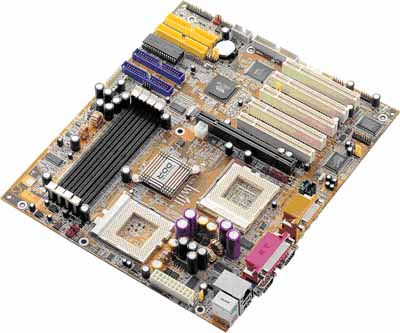

Just days before this roundup was set to be published, we got word from Iwill that they would be releasing a new revision of the DVD266, which introduces quite a few impressive new features. While we were not able to test the board in time for this roundup, we were able to gather quite a bit of information on this upcoming board, known as the DVD266u-RN.
Inheriting the DVD266-R, the DVD266u-RN features a DDR dual Socket-370 motherboard using VIA's Apollo Pro266 platform - Iwill is still the only one in the industry to implement this to date. There are quite a few layout modifications on the DVD266u-RN. For starters Iwill finally moved the power supply connector to the right edge of the board. On the DVD266, the connector is located between the AGP slot and one of the CPU sockets, making it extremely difficult to install or remove the connector. Moreover, the IDE connectors are also moved towards the left side of the board.
In term of features, the DVD266u-RN offers even more than the DVD266-R. The DVD266u-RN is based on the VIA Apollo Pro266T chipset, which supports the new Intel Tualatin processors. Instead of the AMI IDE RAID controller that Iwill has been using on most of their products, the DVD266u-RN features the common Highpoint HPT370 IDE RAID controller. The controller most likely will support the three most common RAID functions, RAID 0, RAID 1, and RAID 0+1. The board will feature an AGP Pro slot instead of the normal AGP slot we found on the DVD266-R. The board will also have an integrated LAN controller for complete network support out of the box.
One of the big things Iwill is pushing is the C-media's CMI8378 six channel hardware sound that has been included on the DVD266u-RN for on-board audio support. Although this setup has been seen on several other boards, the DVD266u-RN is the first to properly support SPDIF through the included SuperAudio module. Iwill is the first in the industry to include this new feature.
Since we did not receive the board in time for publication, we cannot report on performance, stability, or overclocking, although we are confident that the DVD266u-RN will live up to the high standards set by the original DVD266-R.
MSI 694D Pro
|
MSI 694D Pro |
|
|
CPU
Interface
|
Socket-370
|
|
Chipset
|
VIA
Apollo Pro133A
VT 694X North Bridge VT 686A South Bridge |
|
Form
Factor
|
ATX
|
|
Bus
Speeds
|
66 / 75 / 79 / 100 / 110 / 114 / 120 / 124 / 129 / 133 / 138 / 143 / 147 / 152 / 154 / 159 / 162 / 166 / 171 / 180 / 190 / 200 MHz |
|
Voltages
Supported
|
Auto
Detect |
|
Memory
Slots
|
4
168-pin DIMM Slots
|
|
Expansion
Slots
|
1
AGP Slot |
|
On-board
Audio
|
W83971D
AC97 CODEC
|
|
BIOS
|
Award Modular BIOS 6.00PG |
The 694D Pro was actually the first dual Socket-370 motherboard with the Apollo Pro133A chipset to arrive in our labs, shortly after the announcement of SMP support by VIA. And just as impressive as the speed of arrival, the performance and the stability of the board are incredible.
Although the 694D Pro has been out for well over a year, it is still one of the most stable Apollo Pro133A motherboards we have tested to date. Performance suffers slightly due to the 686A South Bridge on board, but nonetheless it's still very decent. Newer versions of the board should have the 686B on-board by now. One downside to the 694D Pro is the lack of an onboard SCSI or IDE RAID controller, something that has been corrected by its successors. Nonetheless, the board offers a two-chip IEEE 1394 Firewire setup.

Promise Ultra ATA 100 IDE controller without RAID support.


Texas Instrument two-chip IEEE 1394 Firewire setup.
Those successors are the 694D Pro2, 694D Pro2-R, and the 694D Pro2-IR, which contain different features like RAID and Firewire depending on the exact model. These boards all have the 686B south bridge. Unlike ASUS, this plethora of models gives you more flexibility in finding a board that suits your needs best.
Overclocking was pretty good on the board as well, hitting 147MHz without any problems. At 152MHz the board lost stability quickly and wasn't able to finish any tests.
If anything, because of the release date of the board, the 694D Pro should be used more as a reference point than a contestant. After all, its successors provide more features and performance. One thing is for sure, the 694D Pro helped set the standard in the value dual Socket-370 motherboard market.
MSI 694D Master-S
|
MSI 694D Master-S |
|
|
CPU
Interface
|
Socket-370
|
|
Chipset
|
VIA
Apollo Pro133A
VT 694X North Bridge VT 686A South Bridge |
|
Form
Factor
|
ATX
|
|
Bus
Speeds
|
66 / 75 / 79 / 83 / 100 / 110 / 114 / 133 / 138 / 143 / 147 / 152 / 154 / 159 / 162 / 166 / 171 / 180 / 190 / 200 MHz |
|
Voltages
Supported
|
Auto
Detect |
|
Memory
Slots
|
4
168-pin DIMM Slots
|
|
Expansion
Slots
|
1
AGP Pro Slot |
|
On-board
Audio
|
VIA
VT1611A AC97 CODEC
|
|
BIOS
|
Award Modular BIOS 6.00PG |
The 694D Master-S, successor to the original 694D Pro, provides more features and will fit the needs of a variety of different users. The 694D Master-S is equipped with an Adaptec AIC-7899G SCSI controller, supporting two 68-pin and one 50-pin connectors on the board.


Adaptec SCSI controller and the three connectors.
Besides the SCSI version, there is also the 694D Pro2, 694D Pro2-R, and the 694D Pro2-IR, which contain different features like RAID and Firewire. Unlike ASUS, this plethora of models gives you more flexibility in finding a board that suits your needs best.
The 694D Master is also equipped with an AGP Pro slot for use with high-end graphic cards, another feature that makes the board ready for a high-end workstaton.

The AGP Pro slot on the 694D Master-S.
One downside of the board is performance, where the numbers are a little bit lower than the other boards. But in terms of stability, the 694D Master-S is incredible, matching other boards to be among the most stable. Overclocking is just the same as that for the 694D Pro, where the board topped out at 147MHz.
In short, the 694D Master-S is a very impressive board, and is ready if you need onboard SCSI. The board is very stable as well, with the only downside being the slightly below average performance. Fortunately, overclocking worked quite well, which could end up being the most important factor for some.
The Performance Test
In recent times, choosing a motherboard cannot be completely determined by a Winstone score. Now, many boards come within one Winstone point of each other and therefore the need to benchmark boards against each other falls. Therefore you should not base your decision entirely on the benchmarks you see here, but also on the technical features and advantages of this particular board, seeing as that will probably make the greatest difference in your overall experience.
|
Test Configuration |
|
| Processor(s): |
2 x Intel Pentium III 733MHz (Retail)
|
| RAM: | |
| Hard Drive(s): |
Western Digital 153BA Ultra ATA
66 7200 RPM
|
| Bus Master Drivers: |
VIA 4-in-1 v4.29 Service Pack
Intel Bus Master Ultra ATA 6.30 |
| Video Card(s): |
NVIDIA
GeForce 2 GTS 32MB DDR
|
| Video Drivers: |
NVIDIA
Detonator 6.50
|
| Operation System(s): |
Windows
2000 Professional
|
| BIOS Revision: |
ABIT
ABIT VP6 Revision 1.0
Acorp 6A815EPD Revision 1.0 AOpen DX34 Plus Revision 1.0 ASUS CUV4X-DLS Revision 1.03 ECS D6VAA Revision 1.1 EPoX EP-D3VA Revision 1.0 Gigabyte 6VXD7 Revision 1.0 Iwill DVD266-R Revision 1.3 MSI 694D Pro Revision 1.0 MSI 694D Master-S Revision 1.0 |
| Software Used: |
Quake
III Arena Demo 001
Ziff Davis Content Creation Winstone 2001 Ziff David Business Winstone 2001 BAPCo SYSMark 2000 CliBench Mk III SMP 0.7.10 CSA Research Benchmark Studio beta 2.0 – Office Bench 2.0 |
Gaming Performance - Quake III Arena

From our experience Quake III Arena scores are generally much higher on boards using Intel chipsets, but as you can see here the Acorp 6A815EPD performs very poorly in the Quake III Arena test. The score is even lower than most single processor i815 motherboards we have tested. This probably means that there is still room for improvement in design for better performance. It's unclear if Acorp had to make some design compromises to accommodate dual processors or if their board simply isn't tweaked for performance.
The Iwill DVD266-R runs out to first place, thanks in large part to the memory bandwidth advantage it holds by the use of DDR SDRAM. Nonetheless, we also notice quite a big performance gap, up to 10%, between boards using the VIA Apollo Pro133A chipset.
Business Performance - Content Creation

Entering the business side of benchmark, we start with Content Creation Winstone 2001. Here we see a much more competitive results, where all the boards fall within a 7% range. The Iwill DVD266-R continues to dominate the performance tests, showing that the added memory bandwidth really helps with dual processing.
Business Performance - Business Winstone 2001
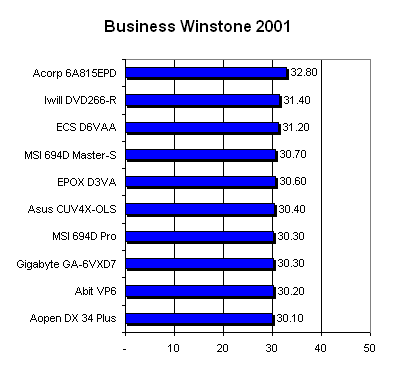
The standings for Business Winstone 2001 are more or less the same as those for Content Creation Winstone 2001. Here the Acorp 6A815EPD jumps out to first place,,edging out the Iwill DVD266-R by 4%, while the Apollo Pro133A boards compete very closely with each other.
Business Performance - SYSMark 2000
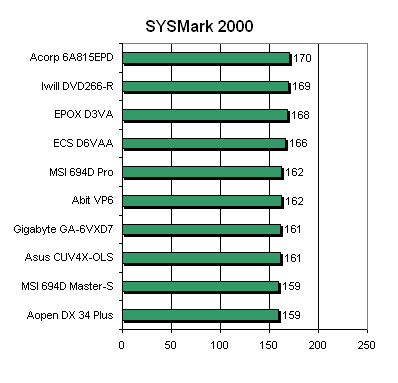
Those of you who are familiar with SYSMark 2000 know that it is not a multi-tasking intensive benchmark, the area in which multiple processors are most useful. Therefore, for dual processor systems, SYSMark 2000 is a less than ideal benchmark for showing the real performance of the board.
However, our test results once again demonstrate something interesting. While the Acorp 6A815EPD and the Iwill DVD266-R continue to clinch the first and second place, the remaining boards using the Apollo Pro133A chipsets again fall into a wide gap of 5%.
Combine these results with those we saw from Content Creation 2001 and Business Winstone 2001, and it is clear that manufacturers have focused enough to make sure that their boards function properly in SMP mode, but have done little to tweak performance.
Business Performance - Office Bench 2.0
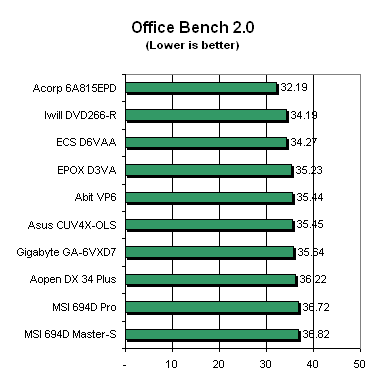
Interestingly enough, the Acorp 6A815EPD came out first in the Office Bench 2.0 test with a 6% lead over the second place Iwill DVD266-R. The rest of the boards also perform pretty well and fall into a narrow gap.
Synthetic Test - CliBench Mk III SMP 0.7.10 (CPU Tests)
|
Windows 2000 Professional |
||||||
|
CliBench
MK III SMP 0.7.10
|
Dhrystones
|
Whetstones
|
Eight Queens | Matrix | Number |
Floating
Point
|
| ABIT VP6 |
2381
|
833
|
3286
|
73015
|
111006
|
11115
|
| Acorp 6A815EPD |
2381
|
833
|
2714
|
78420
|
111400
|
11115
|
| AOpen DX34 Plus |
2379
|
833
|
3286
|
70643
|
111005
|
11115
|
| ASUS CUV4X-DLS |
2398
|
833
|
3286
|
66545
|
111824
|
11186
|
| ECS D6VAA |
2392
|
833
|
3298
|
68131
|
111824
|
11191
|
| EPoX EP-D3VA |
2386
|
833
|
3294
|
70311
|
111400
|
11115
|
| Gigabyte GA-6VVD7 |
2376
|
833
|
3286
|
70134
|
111006
|
11115
|
| Iwill DVD266-R |
2445
|
851
|
3389
|
70437
|
112865
|
11287
|
| MSI 694D Pro |
2392
|
833
|
3290
|
68131
|
111452
|
11186
|
| MSI 694D Master-S |
2392
|
833
|
3277
|
66239
|
111400
|
11115
|
The above table gives the results of some very CPU intensive tests. Since we used two CPUs for all testing, it's a very good indication of how good the SMP implementation is on each motherboard. Once again, the Iwill DVD266-R clinch the top spot, where it edges out all other competitors in every category except the Matrix test.
The Acorp 6A815EPD fluctuates between tests, where it scored very high in the Matrix test but very poorly under the Eight Queens test. Besides that, all other boards perform very similarly, showing that SMP has been implemented properly on all motherboards.
Synthetic Test - CliBench Mk III SMP 0.7.10 (Memory and I/O Tests)
|
Windows 2000 Professional |
|||||||
|
CliBench
MK III SMP 0.7.10 (Memory and Disk)
|
Memory
Throughput
|
Hard
Drive Read
|
Hard
Drive Write
|
||||
|
Max
|
Avg
|
Min
|
Max
|
Avg
|
Min
|
||
| ABIT VP6 |
127932
|
19248
|
14994
|
13084
|
23486
|
22217 |
19248
|
| Acorp 6A815EPD |
142983
|
16410
|
13943
|
12132
|
23486
|
21777 |
18220
|
| AOpen DX34 Plus |
120453
|
19154
|
14037
|
10347
|
22944
|
24954 |
19834
|
| ASUS CUV4X-DLS |
135040
|
19248
|
13382
|
11689
|
25221
|
21917 |
19248
|
| ECS D6VAA |
115748
|
19320
|
14659
|
12132
|
25221
|
21143 |
18720
|
| EPoX EP-D3VA |
121536
|
21787
|
17364
|
14279
|
27464
|
24758 |
21787
|
| Gigabyte GA-6VVD7 |
121536
|
19457
|
14827
|
10916
|
27379
|
24627 |
21787
|
| Iwill DVD266-R |
173622
|
20480
|
16806
|
14222
|
27379
|
24824 |
20480
|
| MSI 694D Pro |
127931
|
15584
|
12828
|
11302
|
21823
|
19852 |
17747
|
| MSI 694D Master-S |
127932
|
21787
|
16136
|
13653
|
29767
|
26432 |
21880
|
The second set of CliBench tests involve memory throughput and I/O performance.
On the memory side, the Iwill DVD266-R outperforms all other boards by a big
margin easily, not a surprise since it uses DDR memory technology while all
other boards are still using SDR SDRAM.
VIA has been criticized for their poor memory performance, and we once again
see that here since among the SDR boards, the Acorp 6A815EPD scores much higher.
Among Apollo Pro133A boards, the ASUS CUV4X-DLS jumps out a bit, mainly because
of its extensive memory tweaking options, while the ECS D6VAA falls behind in
memory performance by quite a bit.
Disk I/O performance is relatively uniform across the board, which isn't a surprise because these tests are usually far more disk limited than controller limited.
Summary
|
Summary |
|||||||
|
FSB
Speed Adjustment
|
Voltage
Tweaking
|
Overclocking Results | RAID / SCSI Controller | PCI/ISA/AMR/CNR | AGP Pro Slot |
Price
|
|
| ABIT VP6 |
Yes
(1MHz increments)
|
Yes
|
155MHz
|
Highpoint
HPT 370 (0, 1, 0+1)
|
5/0/0/0
|
No |
$130
|
| Acorp 6A815EPD |
Yes
|
No
|
133MHz
|
Promise
PDC 20265R (0,1)
|
5/0/0/1
|
No |
$110
|
| AOpen DX34 Plus |
No
|
No
|
N/A
|
Adaptec
AIC 7899-G 2x68-pin Ultra 160
|
5/0/0/0
|
Yes |
N/A
|
| ASUS CUV4X-DLS |
Yes
|
No
|
148MHz
|
LSI
LSA0610 2x68-pin Ultra 160
|
5/0/0/0
|
Yes |
$320
|
| ECS D6VAA |
Yes
|
No
|
150MHz
|
Highpoint
HPT 370 (0, 1, 0+1)
|
5/0/0/1
|
No |
$100
|
| EPoX EP-D3VA |
Yes
|
No
|
142MHz
|
Highpoint
HPT 370 (0, 1, 0+1)
|
5/1/0/0
|
No |
$120
|
| Gigabyte GA-6VVD7 |
Yes
|
No
|
142MHz
|
N/A
|
5/0/0/0
|
No |
$150
|
| Iwill DVD266-R |
Yes
(1MHz increments)
|
Yes
|
145MHz
|
AMI
MG 80649 (0,1, 0+1)
|
5/0/0/0
|
No |
$180
|
| MSI 694D Pro |
Yes
|
Yes
|
147MHz
|
Promise
PDC 20265R (0,1)
|
5/0/0/1
|
No |
$100
|
| MSI 694D Master-S |
Yes
|
Yes
|
143MHz
|
Adaptec
AIC 7899-G
2x68-pin Ultra 160 1x50-pin Ultra 160 |
5/0/0/1
|
Yes |
N/A
|
The Winners and Conclusion
 A little over a year ago, VIA announced that the Apollo Pro133A chipset indeed
supported SMP, and things have never been the same. Together with the drop in
prices for CPUs and the developments in the operating system arena, dual processor
systems are very affordable and quite useful for a lot of people now.
A little over a year ago, VIA announced that the Apollo Pro133A chipset indeed
supported SMP, and things have never been the same. Together with the drop in
prices for CPUs and the developments in the operating system arena, dual processor
systems are very affordable and quite useful for a lot of people now.
Among all these boards, we noticed two major target audiences, one towards IDE users and one towards SCSI users. For the boards that are targeted for IDE users, we found the Iwill DVD266-R to be the best option. It uses the Apollo Pro266 chipset and offers you almost everything you need. Its AMI IDE RAID controller supports the three most common RAID setups. The performance of the board is incredible, thanks in large part to the extra memory bandwidth offered by DDR SDRAM. Each board is also bundled with two Taisol HSF units for better CPU cooling, and overclocking on the board was very good as well. With the price of DDR SDRAM dropping, everyone should consider this board to be used in their dual processor system.
Since we weren't able to get our hands on the DVD266u-RN we can't really crown the board as the winner, but if the DVD266u-RN offers the same, or even better, stability, performance and overclocking, the DVD266u-RN is definitely a killer in the dual Socket-370 market.
On the SCSI side, we also have couple of boards from several big manufacturers as well. Unlike the IDE scenario, the three boards offering SCSI controllers compete very closely with each other. After careful comparison, we decided that the ASUS CUV4X-DLS comes out a bit ahead. It offers a great deal of overclocking and memory tweaking options, and its performance was reasonable as well. It features two 68-pin SCSI channels, and, most importantly, it has an integrated Ethernet controller.
On the other hand, the MSI 694D Master-S is a very nice board as well, offering the same level of stability and performance. If it also has an integrated Ethernet controller, without a doubt it would tie up with the ASUS CUV4X-DLS. The AOpen DX34 Plus is pretty decent as well, but its lack of overclocking ability and poor performance prevent it from being considered among the best.
So here's our value dual socket motherboards roundup. Dual processor is definitely
making its way to the hardware community, and overall we are very impressed
with the stability of the boards we tested here. We are honored to crown two
AnandTech Editor's Choice awards, one to the Iwill DVD266-R as the king of IDE
based motherboards, and the other to the ASUS CUV4X-DLS as the king of SCSI
based boards.
The Winners and Conclusion
 A little over a year ago, VIA announced that the Apollo Pro133A chipset indeed
supported SMP, and things have never been the same. Together with the drop in
prices for CPUs and the developments in the operating system arena, dual processor
systems are very affordable and quite useful for a lot of people now.
A little over a year ago, VIA announced that the Apollo Pro133A chipset indeed
supported SMP, and things have never been the same. Together with the drop in
prices for CPUs and the developments in the operating system arena, dual processor
systems are very affordable and quite useful for a lot of people now.
Among all these boards, we noticed two major target audiences, one towards IDE users and one towards SCSI users. For the boards that are targeted for IDE users, we found the Iwill DVD266-R to be the best option. It uses the Apollo Pro266 chipset and offers you almost everything you need. Its AMI IDE RAID controller supports the three most common RAID setups. The performance of the board is incredible, thanks in large part to the extra memory bandwidth offered by DDR SDRAM. Each board is also bundled with two Taisol HSF units for better CPU cooling, and overclocking on the board was very good as well. With the price of DDR SDRAM dropping, everyone should consider this board to be used in their dual processor system.
Since we weren't able to get our hands on the DVD266u-RN we can't really crown the board as the winner, but if the DVD266u-RN offers the same, or even better, stability, performance and overclocking, the DVD266u-RN is definitely a killer in the dual Socket-370 market.
On the SCSI side, we also have couple of boards from several big manufacturers as well. Unlike the IDE scenario, the three boards offering SCSI controllers compete very closely with each other. After careful comparison, we decided that the ASUS CUV4X-DLS comes out a bit ahead. It offers a great deal of overclocking and memory tweaking options, and its performance was reasonable as well. It features two 68-pin SCSI channels, and, most importantly, it has an integrated Ethernet controller.
On the other hand, the MSI 694D Master-S is a very nice board as well, offering the same level of stability and performance. If it also has an integrated Ethernet controller, without a doubt it would tie up with the ASUS CUV4X-DLS. The AOpen DX34 Plus is pretty decent as well, but its lack of overclocking ability and poor performance prevent it from being considered among the best.
So here's our value dual socket motherboards roundup. Dual processor is definitely
making its way to the hardware community, and overall we are very impressed
with the stability of the boards we tested here. We are honored to crown two
AnandTech Editor's Choice awards, one to the Iwill DVD266-R as the king of IDE
based motherboards, and the other to the ASUS CUV4X-DLS as the king of SCSI
based boards.



